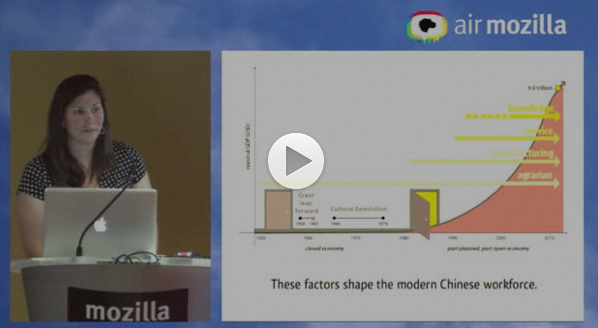Carissa Carter, a design researcher, formerly from Herman Miller, shares what she learned from doing research in Asia for a full year.
Her top 5 lessons learned were:
1) Understand the enhanced impact of recent history.
2) Find the momentum of the population.
3) Tap into self-perceptions.
4) Use images as language.
5) Know what you’re up against and leverage it.
 We also talked about best practices around incentives, translators and scheduling. In China for example, if you interviewed a CFO and a designer at the same company, and you spent an hour with each and each interview was extremely valuable, you would give the CFO a bigger and better incentive. And actually the incentive is viewed more of as a gift – a token of your appreciation – not payment for your time. Physical size matters too, it’s not just the cost of the gift, it has to be bigger in size. They gave planners with the company logo and shinny gold zippers and edges to the CFOs and a shiny jump drive to the lower status participants.
We also talked about best practices around incentives, translators and scheduling. In China for example, if you interviewed a CFO and a designer at the same company, and you spent an hour with each and each interview was extremely valuable, you would give the CFO a bigger and better incentive. And actually the incentive is viewed more of as a gift – a token of your appreciation – not payment for your time. Physical size matters too, it’s not just the cost of the gift, it has to be bigger in size. They gave planners with the company logo and shinny gold zippers and edges to the CFOs and a shiny jump drive to the lower status participants.
As for translators, she cautioned us to spend time picking the right one, since that person is channeling your questions to the participants. She tried using a real time translator, but that didn’t prove to be useful, nor does a translators that asks a question and then tells you the answer afterwards in front of the participant, because that is too slow. For participants who spoke English, she was the primary interviewer, but the local researcher still comes along so that afterwards they can shed light on why the participant made that face as he answered your question or why his answer was actually even more significant than you originally thought.
Scheduling is easy when you know your way or when you are driving yourself around, but in India for example, the traffic is so congested, that something that is 10 minutes away on a map, maybe actually take an hour to get to, so work with your local researcher for scheduling too.
There are so many more details in her talk, it’s definitely worth watching her talk and reading her slides. Thanks, Carissa!